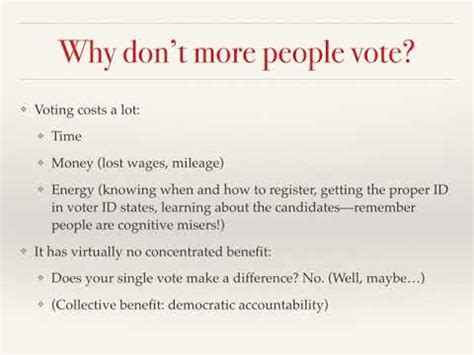Understanding Rational Choice Voting
Rational choice voting theory suggests that voters make decisions based on a rational calculation of their self-interest. According to this theory, voters weigh the costs and benefits of each candidate and policy option before casting their ballots.

Key Principles of Rational Choice Voting
- Self-interest: Voters vote for candidates or policies they believe will benefit them the most.
- Cost-benefit analysis: Voters consider the potential gains and losses associated with each option.
- Marginal utility: Voters choose the option that provides the greatest incremental value (known as marginal utility) compared to the sacrifices they must make.
- Strategic voting: Voters may not always vote for their preferred candidate if they believe their vote will not make a difference or if they can influence the outcome by supporting a stronger candidate.
Factors Influencing Rational Choice Voting
Several factors can influence how voters make rational choice decisions:
- Candidate characteristics: Voters consider the candidates’ experience, qualifications, and policy positions.
- Policy preferences: Voters evaluate how the candidates’ policies align with their own views.
- Party identification: Voters tend to vote for candidates from their preferred political party.
- Salience: Voters are more likely to consider issues that are most important to them.
- Electoral rules: The electoral system (e.g., first-past-the-post, proportional representation) can affect voters’ strategic decisions.
Examples of Rational Choice Voting
- Voting for a candidate who promises lower taxes: A voter may choose this candidate if they believe it will reduce their financial burden.
- Supporting a policy that expands healthcare coverage: A voter may vote for this policy if they believe it will improve their access to affordable healthcare.
- Voting strategically for a less preferred candidate: A voter may vote for a stronger candidate to prevent a more extreme candidate from winning.
Why Rational Choice Voting Matters
Rational choice voting theory is important because it helps explain the behavior of voters and provides a framework for analyzing electoral outcomes. It also highlights the role of self-interest and strategic thinking in decision-making.
Benefits of Rational Choice Voting
- Efficiency: Rational choice voting can lead to more efficient outcomes if voters are well-informed and make decisions based on sound reasoning.
- Accountability: Candidates and policymakers are held accountable to voters’ preferences through rational choice voting.
- Democratic legitimacy: Rational choice voting supports the democratic principle of government “by the people” because it reflects the collective will of the citizenry.
Common Mistakes to Avoid in Rational Choice Voting
- Assuming voters are always rational: Voters may be influenced by emotions, biases, or other factors that deviate from rational decision-making.
- Overlooking the influence of norms: Social norms and group dynamics can shape voters’ preferences and behavior.
- Ignoring the role of institutions: Electoral rules and institutions can influence the incentives and constraints on voters’ choices.
- Assuming a single “rational” vote: Voters can hold different values and perspectives, leading to a variety of rational choices.
How to Vote Rationally
- Educate yourself: Learn about the candidates, policies, and electoral rules.
- Consider your values and preferences: Determine what is most important to you and how the candidates align with your views.
- Weigh the costs and benefits: Consider the potential gains and losses of each option.
- Be strategic when necessary: If your preferred candidate is unlikely to win, consider voting for a stronger candidate who can advance your interests.
- Vote: Exercise your right to vote and make your voice heard.
Tables
| Table 1: Factors Influencing Rational Choice Voting |
|—|—|
| Candidate characteristics | Policy preferences | Party identification |
| Salience | Electoral rules | Socioeconomic status |
| Table 2: Examples of Rational Choice Voting |
|—|—|
| Voting for a candidate who promises lower taxes | Supporting a policy that expands healthcare coverage | Voting strategically for a less preferred candidate |
| Table 3: Benefits of Rational Choice Voting |
|—|—|
| Efficiency | Accountability | Democratic legitimacy |
| Table 4: Common Mistakes to Avoid in Rational Choice Voting |
|—|—|
| Assuming voters are always rational | Overlooking the influence of norms | Ignoring the role of institutions |
| Assuming a single “rational” vote |
